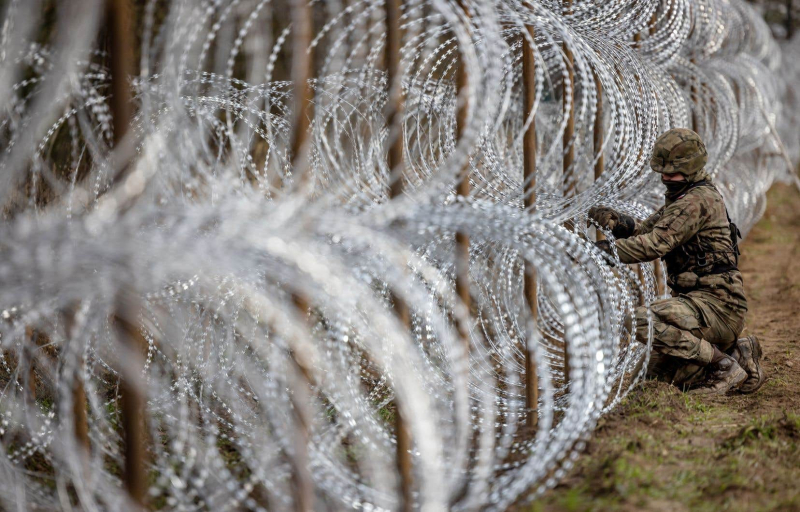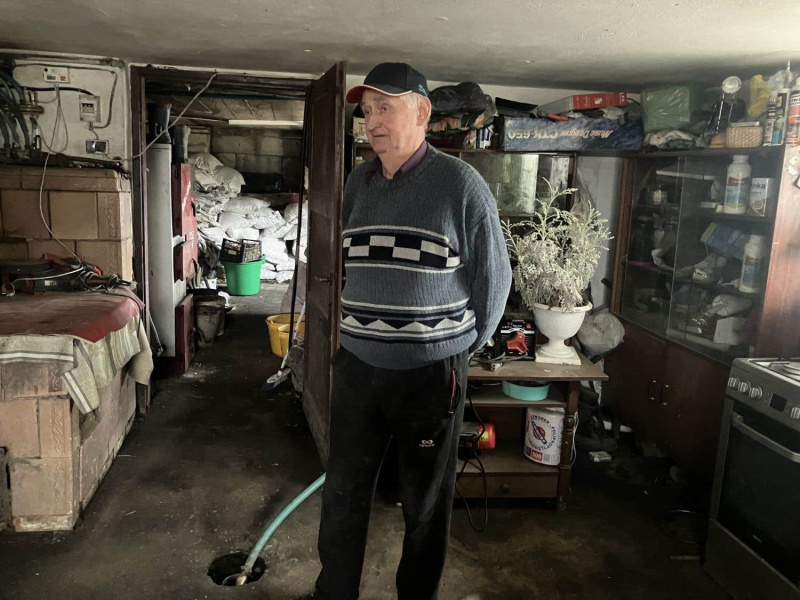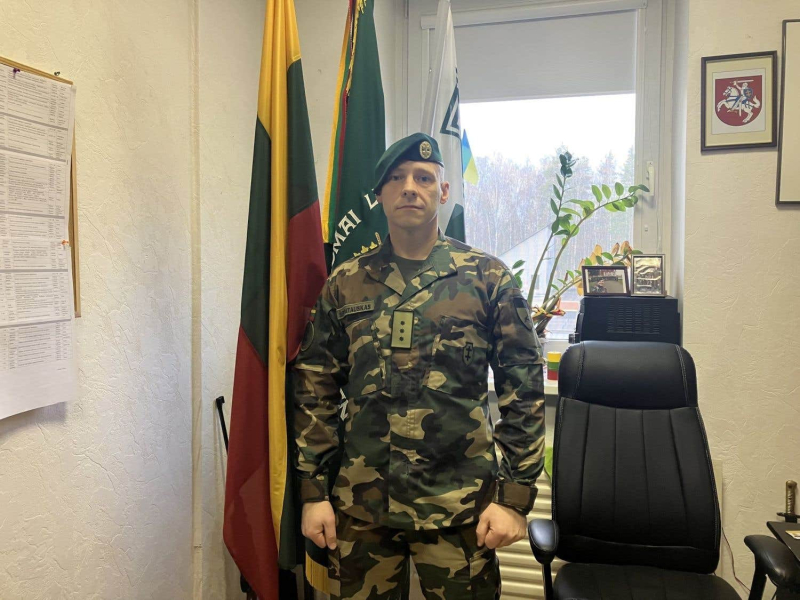
Photo: Wojtek Radwanski archives Agence France-Presse En novembre 2022, le gouvernement polonais avait annoncé la construction d’une clôture le long de la frontière avec l’enclave russe de Kaliningrad, dans le nord-est de la Pologne.
In a time not so long ago, it was a tourist attraction, a source of curiosity for history lovers or simple visitors. A sort of relic of a territorial layout dating from 1389, from a time when the Grand Duchy of Lithuania and Teutonic Knights reigned.
Today, under the gloomy grayness of mid-March, the border stele stamped “Republic of Poland” on the edge of Lithuania and the Russian enclave of Kaliningrad embodies the wind of the Cold War which blows over this region on the borders of the European Union. There, all around the monolith, rises an imposing team of barbed wire, extended on the Lithuanian side by a metal fence and on the Polish side by other barbed wire as far as the eye can see. Along their border with the Russian enclave of Kaliningrad, Warsaw and Vilnius barricade themselves in the face of Moscow's destabilizing maneuvers.
A scene testifying, if ever there was one, to a tense geopolitical context, in a Europe where war has once again intruded.
“A change of times,” sigh Daniela and Mieczysław Ceglarski, 65 and 67 years old, from their home, located a stone’s throw from the confined stele. This Polish couple remembers the time when their neighbors from Kaliningrad, just a few years ago, came to Poland to do their shopping. A bygone period.

Photo: Patrice Senécal Le Devoir Mieczysław Ceglarski, 67, lives with his wife in a village in northeastern Poland adjoining the border with the Russian enclave of Kaliningrad. “Even if they attack, we will stay here, since we have nowhere to go.”
The fear of a Russian attack consumes them: the Ceglarski couple lives in the heart of the Suwałki corridor, a strip of land of just under 100 kilometers running along the Polish-Lithuanian border and considered to be the Achilles heel of the NATO. Because if the Russians “decide to disembark, we will be the first on their way,” slips Daniela with resignation, flowered jacket on her back. “But we will stay here: we have nowhere to go,” continues her husband, Mieczysław. The cellar where canned goods and foodstuffs are piled up could certainly serve as a refuge for them, “but with today’s weapons, we would quickly be buried,” he quips.
In the surrounding area, fields, hills and winding roads stretch as far as the eye can see, passing grazing cows here, yet another village there. The “Suwałki Corridor” exudes the serenity of an ordinary countryside. And yet, some call it “the most dangerous place in the world.” Is the adjective excessive ? For the day visitor, the region has nothing a priori of a battlefield or a bloody trench of the eastern front of Ukraine.
The fact remains that this piece of territory is, in the eyes of the Western allies, of a highly strategic nature. Named after the small town of Suwałki, in the north-east of Poland, it has the particularity of being stuck between two territories serving the Kremlin. On one side, the Russian enclave of Kaliningrad, heavily militarized and equipped with nuclear warheads; on the other, to the southeast, Belarus subservient to Moscow, where up to 800 mercenaries from the Wagner group are still stationed.
It is through this, military strategists fear, that Vladimir Putin's Russia could attempt to encircle and then invade the Baltic countries – all members of NATO – by cutting their land link with Poland, and therefore with the rest of Europe. NATO's military presence has thus been reinforced in the Suwałki corridor, in addition to the alliance troops already deployed in the three Baltic countries.
Between serenity and anguish
Faced with the specter of an attack launched by Moscow, the local population oscillates between fatalism and carelessness.
There are those, like Henryka Radzewicz, who refuse to give in to anxiety, to the point of turning the threat into ridicule. “The danger is greater in Warsaw, where we are more likely to be hit by a car than we are to be invaded by the Russians! » says the resident, who praises a region “where life is peaceful”. In Stankuny, where she runs an agrotourism lodge, the border with Kaliningrad is less than a kilometer away. Wouldn't that be where the Kremlin troops would emerge in the event of an escalation of tensions ? “And what's the point of invading small villages like here ? And then, we're in NATO, we're in security,” proclaims the fifty-year-old. Many are also annoyed to see tourists deserting their region, which has a bad press.
Others, like Jolanta Falecka, round and affable face, do not display the same serenity. “It doesn’t smell very good…” euphemizes this 58-year-old cheese maker. She sees the future with uncertainty. “Before, the Russians were satisfied with threats. But we clearly saw that by attacking Ukraine two years ago, they reached a milestone: we could, in Poland, be next. » What to do in a crisis ? Jolanta has no idea. “All I could use is cheese. I don't have a cellar, I couldn't hide. And when we see what they did to Boutcha…”
Here, no one has any illusions about what a Russian occupation could mean. Mentioned in whispers, the atrocities committed by the Kremlin army in the suburbs of kyiv or in Izioum are present in many minds.
An improbable invasion, for the moment
The prospect of a Russian invasion in the Suwałki corridor nevertheless remains unlikely in the short term, in the opinion of Jacek Tarociński, defense researcher at the Warsaw-based Center for Oriental Studies. Busy waging its war against Ukraine, the Kremlin does not have the military capabilities and is already suffering heavy losses. “Parts of the 11th Army Corps, stationed in Kaliningrad, took part in the war, especially near Kupiansk [on the front line], losing many men and equipment to the Ukrainian forces,” explains M. .Tarociński.
But Vladimir Putin's Russia, which has switched to a war economy, “has not lost its means of producing weapons, which are superior to those of Western European countries”, warns the researcher. And against a backdrop of successive debacles for the kyiv army, the Russian threat is growing. Faced with a Russia whose imperialist aims leave little room for doubt – and capable of reconstituting its armed forces within five years – military experts and general staffs are calling for a pull together.
“Until the current war in Ukraine reaches any conclusion, Russia cannot invade NATO countries. […] However, NATO, a defensive alliance by nature, must deter Russia from invading us, and to do this, the only way is to prepare for it. And to show Russia that if [its soldiers] invade us, they will perish. Because the only language the Kremlin understands is force,” continues Mr. Tarociński.
Also, at the end of January, the 32 countries of the Atlantic Alliance began the Steadfast Defender 2024 military exercise on the Old Continent, on a scale unequaled since the end of the Cold War.

Photo: Patrice Senécal Le Devoir Ramūnas Šerpatauskas leads the 103rd company of the Lithuanian Riflemen's Union, a state-supported volunteer defensive structure. He recalls that “this Russian invasion in Ukraine means that we must prepare, because the Russians can attack us at any time.”
Prepare for the worst
On the Lithuanian side of the corridor, in the sleepy little town of Vištytis, canton chief Anatolijus Lesnickas hammers home the same message as Jacek Tarociński: “We have to prepare. » The neighboring lake, named in honor of its city, acts as a natural border with the Russian enclave of Kaliningrad, which stands on the other side of the body of water. “In the event of an attack, we would be busy in a few hours,” fears the man with long white hair and the air of a rocker who welcomes us into his office.
He admits to having already prepared, “just in case”, an emergency bag with some food, a sleeping bag and a flashlight. “The allies say they will defend us, but can we be certain ?” The possible return to the leadership of the United States of Donald Trump, who has more than once called into question the solidity of Atlantic Alliance, worries it.
Still in Lithuania, in the small town of Druskininkai, three kilometers from Belarus, Ramūnas Šerpatauskas keeps his cool. With close-cropped hair under his green beret, the 44-year-old soldier leads the 103rd company of the Lithuanian Riflemen's Union, a state-supported defensive structure with some 14,000 volunteer members. As for the possibility of an attack on the Suwałki corridor and the Baltic countries, he rebelliously says: “They will come up against our resistance, we are not afraid. And then, the territory is not easy here. If they arrive by parachute, that's what our guns will be used for. »

